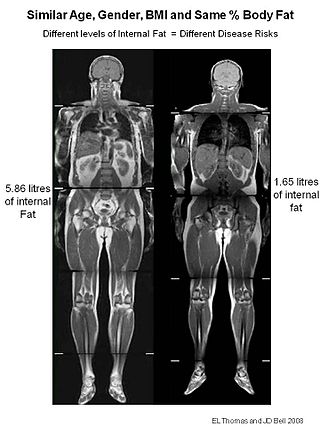
Body mass index (BMI) is a value derived from the mass (weight) and height of a person. The BMI is defined as the body mass divided by the square of the body height, and is expressed in units of kg/m2, resulting from mass in kilograms (kg) and height in metres (m).

Metabolic syndrome is a clustering of at least three of the following five medical conditions: abdominal obesity, high blood pressure, high blood sugar, high serum triglycerides, and low serum high-density lipoprotein (HDL).

Abdominal obesity, also known as central obesity and truncal obesity, is the human condition of an excessive concentration of visceral fat around the stomach and abdomen to such an extent that it is likely to harm its bearer's health. Abdominal obesity has been strongly linked to cardiovascular disease, Alzheimer's disease, and other metabolic and vascular diseases.

Obesity is a medical condition, sometimes considered a disease, in which excess body fat has accumulated to such an extent that it can potentially have negative effects on health. People are classified as obese when their body mass index (BMI)—a person's weight divided by the square of the person's height—is over 30 kg/m2; the range 25–30 kg/m2 is defined as overweight. Some East Asian countries use lower values to calculate obesity. Obesity is a major cause of disability and is correlated with various diseases and conditions, particularly cardiovascular diseases, type 2 diabetes, obstructive sleep apnea, certain types of cancer, and osteoarthritis.

The waist is the part of the abdomen between the rib cage and hips. Normally, the waist is the narrowest part of the torso.

The waist–hip ratio or waist-to-hip ratio (WHR) is the dimensionless ratio of the circumference of the waist to that of the hips. This is calculated as waist measurement divided by hip measurement. For example, a person with a 75 cm waist and 95 cm hips has WHR of about 0.79.
The body fat percentage (BFP) of a human or other living being is the total mass of fat divided by total body mass, multiplied by 100; body fat includes essential body fat and storage body fat. Essential body fat is necessary to maintain life and reproductive functions. The percentage of essential body fat for women is greater than that for men, due to the demands of childbearing and other hormonal functions. Storage body fat consists of fat accumulation in adipose tissue, part of which protects internal organs in the chest and abdomen. A number of methods are available for determining body fat percentage, such as measurement with calipers or through the use of bioelectrical impedance analysis.
Sagittal abdominal diameter (SAD) is a measure of visceral obesity, the amount of fat in the gut region. SAD is the distance from the small of the back to the upper abdomen. SAD may be measured when standing or supine. SAD may be measured at any point from the narrowest point between the last rib and the iliac crests to the midpoint of the iliac crests.

Human body shape is a complex phenomenon with sophisticated detail and function. The general shape or figure of a person is defined mainly by the molding of skeletal structures, as well as the distribution of muscles and fat. Skeletal structure grows and changes only up to the point at which a human reaches adulthood and remains essentially the same for the rest of their life. Growth is usually completed between the ages of 13 and 18, at which time the epiphyseal plates of long bones close, allowing no further growth.
The obesity paradox is the finding in some studies of a lower mortality rate for overweight or obese people within certain subpopulations. The paradox has been observed in people with cardiovascular disease and cancer. Explanations for the paradox range from excess weight being protective to the statistical association being caused by methodological flaws such as confounding, detection bias, reverse causality, or selection bias.

Being overweight is having more body fat than is optimally healthy. Being overweight is especially common where food supplies are plentiful and lifestyles are sedentary.

Female body shape or female figure is the cumulative product of a woman's bone structure along with the distribution of muscle and fat on the body.

Obesity classification is a ranking of obesity, the medical condition in which excess body fat has accumulated to the extent that it has an adverse effect on health. The World Health Organization (WHO) classifies obesity by body mass index (BMI). BMI is further evaluated in terms of fat distribution via the waist–hip ratio and total cardiovascular risk factors. In children, a healthy weight varies with age and sex, and obesity determination is in relation to a historical normal group.

Android fat distribution describes the distribution of human adipose tissue mainly around the trunk and upper body, in areas such as the abdomen, chest, shoulder and nape of the neck. This pattern may lead to an "apple”-shaped body or central obesity, and is more common in males than in females. Thus, the android fat distribution of men is about 48.6%, which is 10.3% higher than that of premenopausal women. In other cases, an ovoid shape forms, which does not differentiate between men and women. Generally, during early adulthood, females tend to have a more peripheral fat distribution such that their fat is evenly distributed over their body. However, it has been found that as females age, bear children and approach menopause, this distribution shifts towards the android pattern of fat distribution, resulting in a 42.1% increase in android body fat distribution in postmenopausal women. This could potentially provide evolutionary advantages such as lowering a woman's center of gravity making her more stable when carrying offspring.
A person's waist-to-height ratio (WHtR), occasionally written WtHR or called waist-to-stature ratio (WSR), is defined as their waist circumference divided by their height, both measured in the same units. It is used as a predictor of obesity-related cardiovascular disease. The WHtR is a measure of the distribution of body fat. Higher values of WHtR indicate higher risk of obesity-related cardiovascular diseases; it is correlated with abdominal obesity.

TOFI (thin-outside-fat-inside) is used to describe lean individuals with a disproportionate amount of fat stored in their abdomen. The figure to illustrate this shows two men, both 35 years old, with a BMI of 25 kg/m2. Despite their similar size, the TOFI had 5.86 litres of internal fat, whilst the healthy control had only 1.65 litres.

A Body Shape Index (ABSI) or simply body shape index (BSI) is a metric for assessing the health implications of a given human body height, mass and waist circumference (WC). The inclusion of WC is believed to make the BSI a better indicator of risk of mortality from excess weight than the standard body mass index. ABSI correlates only slightly with height, weight and BMI, indicating that it is independent of other anthropometric variables in predicting mortality.
Normal weight obesity is the condition of having normal body weight, but with a high body fat percentage, leading to some of the same health risks as obesity.
Rachael Waring Taylor is a New Zealand childhood nutrition academic. She is currently a full professor at the University of Otago.
Relative Fat Mass (RFM) is a simple formula for the estimation of overweight or obesity in humans that requires only a calculation based on a ratio of height and waist measurements.












